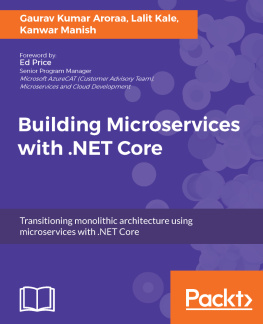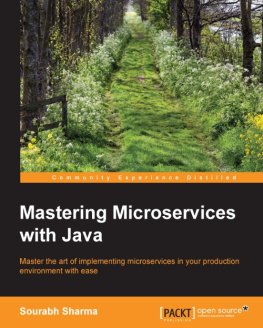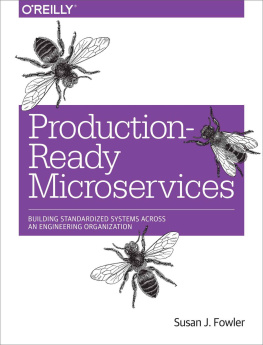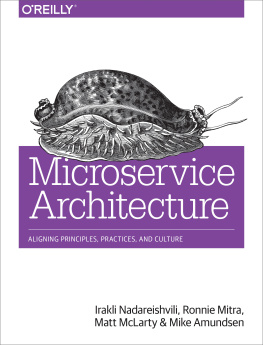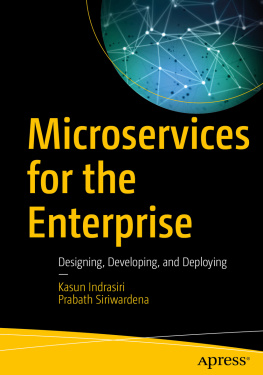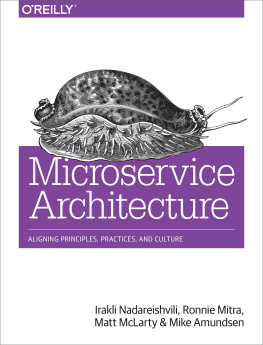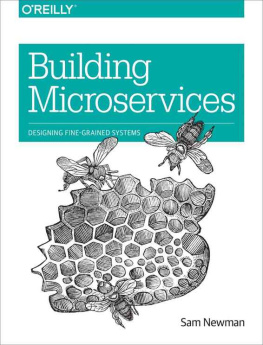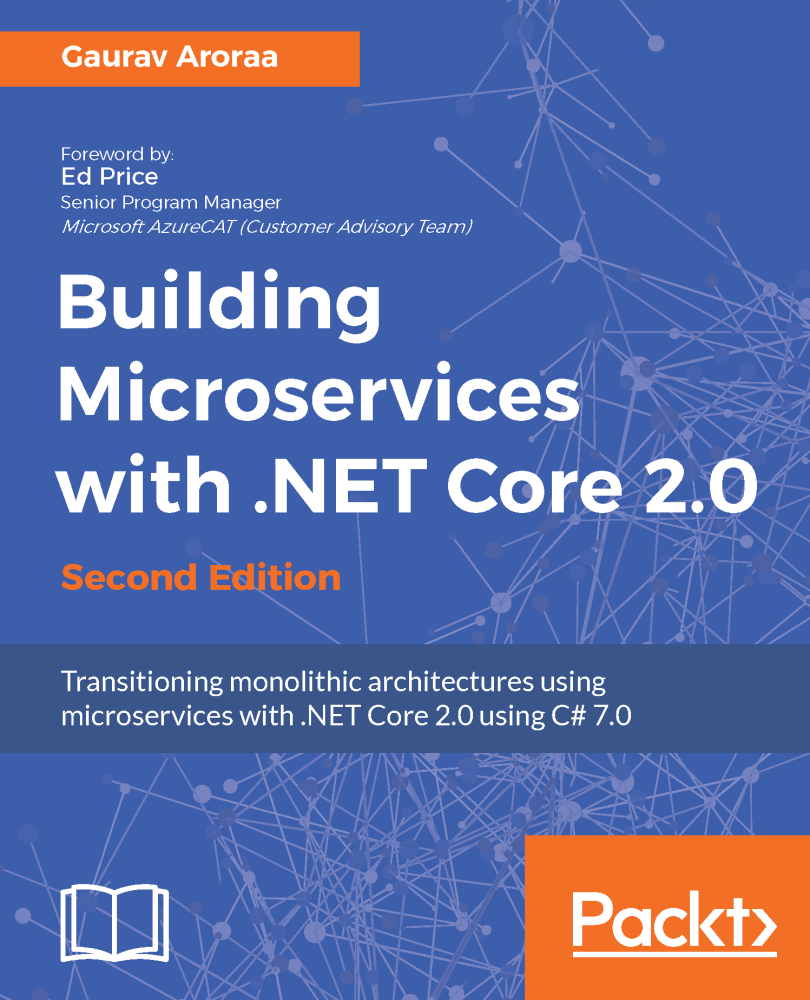
Building Microservices with .NET Core 2.0
Second Edition
Transitioning monolithic architectures using microservices with .NET Core 2.0 using C# 7.0
Gaurav Aroraa
BIRMINGHAM - MUMBAI
Building Microservices with .NET Core 2.0
Second Edition
Copyright 2017 Packt Publishing
All rights reserved. No part of this book may be reproduced, stored in a retrieval system, or transmitted in any form or by any means, without the prior written permission of the publisher, except in the case of brief quotations embedded in critical articles or reviews.
Every effort has been made in the preparation of this book to ensure the accuracy of the information presented. However, the information contained in this book is sold without warranty, either express or implied. Neither the author, nor Packt Publishing, and its dealers and distributors will be held liable for any damages caused or alleged to be caused directly or indirectly by this book.
Packt Publishing has endeavored to provide trademark information about all of the companies and products mentioned in this book by the appropriate use of capitals. However, Packt Publishing cannot guarantee the accuracy of this information.
First published: June 2017
Second edition: December 2017
Production reference: 1211217
Published by Packt Publishing Ltd.
Livery Place
35 Livery Street
Birmingham
B3 2PB, UK.
ISBN 978-1-78839-333-1
www.packtpub.com
Credits
Author
Gaurav Aroraa | Copy Editor
Safis Editing |
Reviewer
Jeffrey Chilberto | Project Coordinator
Ulhas Kambali |
Commissioning Editor
Merint Mathew | Proofreader
Safis Editing |
Acquisition Editor
Denim Pinto | Indexer
Francy Puthiry |
ContentDevelopmentEditor
Vikas Tiwari | Graphics
Jason Monteiro |
Technical Editor
Jash Bavishi | Production Coordinator
Shantanu Zagade |
Foreword
"Our industry does not respect tradition it only respects innovation."
- Satya Nadella
Those words from Satya ring true with microservice architectures. I believe that microservices are a crucial spark of innovation in web development. In an agile world, we need an agile framework in the cloud that is working for us, processing individual actors and services. With this new power, we can deploy a framework that scales, improve resiliency, greatly reduces latency, increases our control of security, and upgrade the system without downtime. Microservices becomes the optimal architecture in our new, cloud-based development environment, and it can result in major cost benefits.
Gaurav Aroraa masterfully takes us on a journey to explore the history of microservices. He carefully and thoroughly tours the architectural design concepts that accompany the evolution of microservices, from when James Lewis first coined the term to our current tools and implementations.
The book starts at a high level, with detailed diagrams and descriptions that explain the architectural scenarios, and it uncovers all the values that youll receive with a microservices design. At this point, you might ask whether the book is about microservices architecture or is a how-to guide to .NET development. Importantly, the book provides practical knowledge about translating our current applications into this bold new world of microservices. On that journey, it does not speed up. In other books, you move so fast that you cant understand how or why it works (you can only follow the instructions). You might code and pick up a few tactics along the way, mostly copying and coding by autopilot. However, this book teaches each concept and step in the development process with the attention and focus that it deserves.
In this second edition, Gaurav has crafted the most comprehensive book on microservice development. Im excited to see him expand on new options for building microservice architectures. Join Gaurav, as you learn about Azure Service Fabric, Service Bus, Message Queuing, and more!
Personally, I have had the privilege to know Gaurav for a few years now. Hes a Visual Studio and Development MVP (Microsoft Most Valuable Professional) awardee and a leader in the Microsoft cloud development community. Ive worked closely with him on his powerful contributions to TechNet Wiki. In Building Microservices for .NET Core, I see his dedication and passion shine through. This book needed to be written. I am excited when I find gems like this. Gaurav thoroughly covers every detail, every parameter, and every consideration in tackling this weighty concept of developing a microservices architecture. Read this book, skip ahead where youre knowledgeable about the given information, and absorb the authors knowledge; share the book with your business contacts. The development community needs to adopt a microservices approach, and this book is a powerful advocate on that journey.
Ed Price
Senior Program Manager
Microsoft Azure CAT (Customer Advisory Team)
Co-Author of Learn to Program with Microsoft Small Basic
About the Author
Gaurav Aroraa has an M.Phil in computer science. He is a Microsoft MVP, certified as a scrum trainer/coach, XEN for ITIL-F, and APMG for PRINCE-F and PRINCE-P. Gaurav serves as a mentor at IndiaMentor and webmaster at dotnetspider, and he cofounded Innatus Curo Software LLC. In more than 19 years of his career, he has mentored over a thousand students and professionals in the industry. You can reach to Gaurav via Twitter: @ g_arora.
Book writing is not an easy job, as it takes time a lot of time. Sometimes, it needs your personal/family time. So, I want to thank all who motivated me and allowed me to spend time with this book, which I was supposed to spend with them. My first thank you goes to my wife, Shuby Arora, for her constant support throughout. Then, I would like to thank my angel, Aarchi Arora. I would also like to thank the entire Packt team, especially Vikas Tiwari, Jash Bavishi, Diwakar Shukla, Ulhas Kambale, and Denim Pinto for their overnight support. Without the technical reviewer, it's hard to make the content appealing to the readers. So, I would like to thank Jeffrey Chilberto whose precise and to-the-point reviews enriched the book's content. I would also like to thank the entire MVP community, especially Deepak Rajendra Indian MVP Lead. His words and support further fuelled my desire to write this book. A special thanks to Shivprasad Koirala, who guided me from time to time at various junctures of writing this book. Thanks to the TechNet Wiki community, the Azure community, and to all the lovely folks: Ronen, Kamlesh, Arlan, Syed, Peter Geelen, Pedro aka Pete Laker, and all other champs. Thanks to my friends who motivated me: Chandershekhar Thota, Kanwwar Manish, Ram Nath Rao, Lalit Kale, Pooja (the champ), and Tadit (the bug trapper).
Next page

